MANILA, Philippines - Can wastes ultimately find their way to our tables?
This is what the Marinduque State College explored in one of their studies under the project, “Enhancing Productivity and Viability of Arrowroot Industry in Marinduque,” which was supported by the Bureau of Agricultural Research under the Department of Agriculture’s high value crops development program.
According to project leader Michael Capina, arrowroot is a local rootcrop that grows in the province of Marinduque. It forms one of the profitable industries in the province due to the high quality of the sought after by-product, which is starch, that can be extracted from its rhizomes.
With its superior properties – in food preparation and its easy digestibility – pastries such as the popular arrowroot cookies of Marinduque, biscuits, and other bakery products are being made out of it.
Arrowroot starch is also being used for non-food purposes with its applications in the cosmetic and pharmaceutical industries.
Capina and his team, however, observed that only 45 percent of the rhizomes are being utilized for starch.
“During the usual extraction process, recovery for starch ranges from 13 to 20 percent only, with 27 to 35 percent remaining as rhizome residues, and 45 to as much as 60 percent of water,” he explained.
Hence, their study focused specifically on utilizing the rhizome waste materials from the extraction process of arrowroot starch to produce arrowroot flour.
In their study, waste rhizomes (sapal) were washed and dried afterward. After drying, the waste rhizomes were ground two to three times to produce the flour. This flour was then used to make brownies and cookies.
“Results of proximate analysis showed that the flour derived from waste rhizomes is comparable to the arrowroot starch extracted with the usual process, in fact, with even higher crude fiber content than the starch,” Capina said.
The products, however, are still being subjected to further improvement alongside testing and analysis.
Apart from human consumption, the flour is also being studied for its potentials as an animal feed material. “We are exploring the expanded utilization of arrowroot by-products to help reduce environmental pollution resulting from direct discharge of unused by-products,” Capina said.
Capina and his team likewise tried developing novelty items from wastes of different arrowroot plant parts such as handmade paper from leaves, picture frame, fan, and pen holder from stalks, paper bag from rhizome skins, and cardboard and tissue holder from waste rhizomes.









